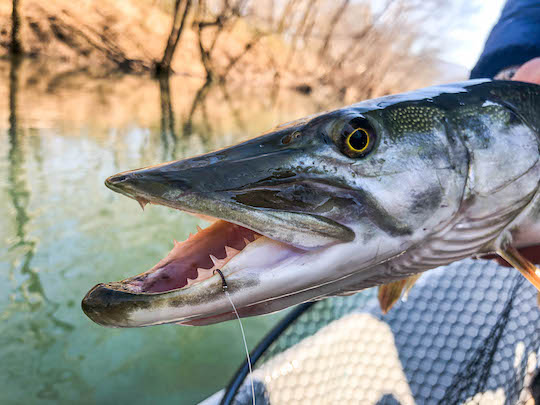Fishing new water is always exciting. Whether wading or floating, seeing a piece of water for the first time is a treat that shouldn't be taken lightly. After all, given enough time, an angler can exhaust most of their local options for seeing new water. It takes a while, but eventually you realize that you've seen most of the places there are to fish in your neck of the woods.
For me, there are some rivers that I've seen almost every fishable inch, and others that I can honestly say I've fished, but definitely wouldn't say I've got them dialed in yet. That only comes with repetition, more for some people than others, but still requires a decent number of fishing trips. I'm fortunate that I'm blessed with a memory for water. Take me to a stream one time, and I've got a pretty good idea about fishing it in the future.
On new to me water, the lack of any pre knowledge makes for an exciting day. The constant discovery process is invigorating. Recently, I got to do just that on two separate occasions. The more recent was a backpacking trip in the Smokies that I'll get to in another post. The other occasion was what seems ages ago, but was really not even a month and a half ago. My good friend and fellow fly fishing guide and smallmouth guru Chris Bean was up for an adventure and had the perfect boat for scouting remote smallmouth water. I had some insight on a put-in and take-out option, and a plan was hatched.
We met at the take-out, then drove up to the sketchy boat launch well upriver. The more I hang out with these smallmouth guys, the more I realize that the term "boat launch" is a pretty loose concept. Regardless, we got the raft in the water, and started working our way down the river.
 |
| Early morning light on a smallmouth stream. ©2025 David Knapp Photography |
Things were slower than either of us liked, but we were catching some fish. For this trip, catching fish was really just the icing on the cake. More than anything, it was about a remote float on a new to each of us piece of water. We did both have opportunities and also both caught some nice fish. We both lost fish that would likely have been a new personal best, but things slowed down by mid morning. It all made sense when Chris took a water temp and we discovered it was in the mid 80s. Those summer heat waves are hard on anglers and fish and this day was no exception.
 |
| My best smallie on this summer exploration float. Photo Courtesy of Chris Bean ©2025 |
We should have seen it coming. The heat had been building all day. In fact, when we finally had to jump out of the boat after bumping through countless riffles without getting hung up, it was almost a relief. The water, although hot, was better than the air temperature at that point. Of course, heat leads to instability, and instability leads to thundershowers.
 |
| Those little clouds look harmless, but they soon built into quite a storm. ©2025 David Knapp Photography |
By the time we were clearing the last significant riffle and jumped back in the boat, the sky was turning darker. I don't mind fishing in the rain. I do it more than I really like thanks to my job as a fly fishing guide. Oddly enough I've morphed into a fair weather angler, all the more strange because I still love a good rainy day, but the one place I always draw the line is with lightning.
I was keeping a close eye on the storm via a radar app on my phone. It was clearly bearing down on us and doubtful if we were going to stay dry. It hadn't been thundering too much until it got close. Then things got interesting in a hurry. When lightning started hitting the ridge just above us, it was time to pull over. I jumped out on a huge flat rock ledge and we told stories for a while. A glance up river suggested the heaviest rain hadn't even started yet.
 |
| Heavy rain. ©2025 David Knapp Photography |
 |
| Yep, that's a lot of water. ©2025 David Knapp Photography |
Eventually, the storm eased on past and the lightning moved on to our south. The thunder got softer and softer until we felt quite safe getting back out on the water. Hopeful that the cooldown would send the fish into a feeding frenzy, we started fishing hard the last bit of our day.
Chris rolled a big bass or two on a streamer, but I was starting to wind down. I've noticed that I don't fish as hard as I used to most of the time. Knowing when to quit is almost as important as going in the first place. Happy to row while Chris fished, I guided the boat slowly downstream as the rain receded into the distance. The late day feeding frenzy didn't seem likely and we both were needing to get home at a reasonable hour.
The rest of our trip was anticlimactic, running the shuttle, pulling the boat out, essential tasks like that. We were both already plotting a return, however. New water won't become old hat without at least a few visits. Both of us left wanting to return and dial things in a little better. We agreed that a little more flow would be nice, however.



























